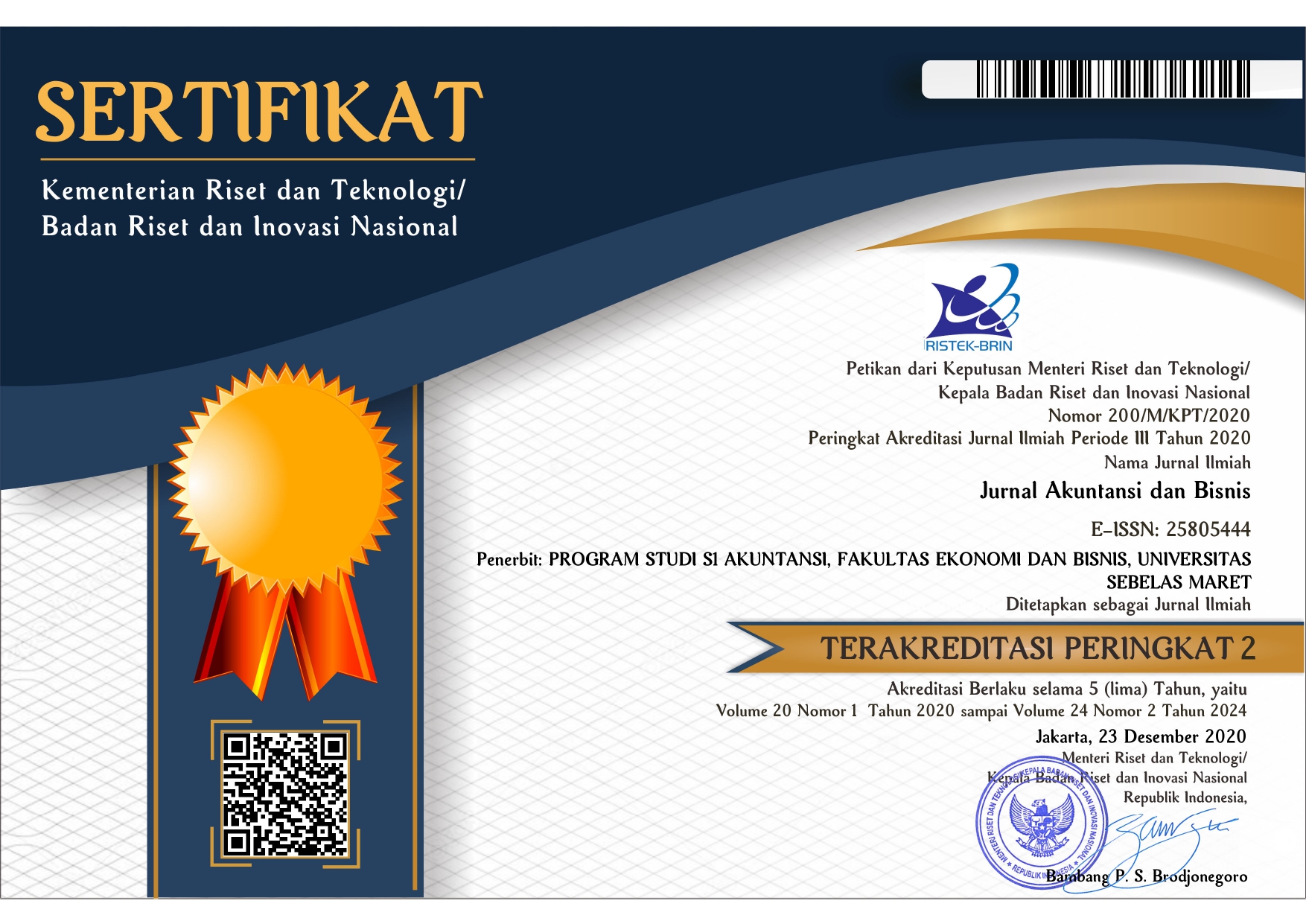The Effect of Business Strategies and Financial Reporting Irregularities On Audit
Abstract
Penelitian ini bertujuan untuk menguji dan menganalisis pengaruh strategi bisnis dan penyimpangan pelaporan keuangan terhadap fee audit. Strategi bisnis diukur dengan enam ukuran komprehensif: rasio penelitian dan pengembangan, rasio karyawan, perubahan pendapatan, rasio beban penjualan, rasio perputaran karyawan, dan intensitas modal. Penyimpangan pelaporan keuangan diukur dengan indikasi penyimpangan laporan keuangan, dan fee audit diukur dengan jumlah logaritma fee audit perusahaan. Pemilihan sampel menggunakan metode purposive sampling dan terpilih 314 perusahaan yang memenuhi kriteria penelitian ini. Penelitian ini dilakukan dari tahun 2017 hingga 2019. Hasil dari penelitian ini menunjukkan bahwa penyimpangan pelaporan keuangan dan strategi bisnis berpengaruh signifikan terhadap fee audit. Secara ringkas, hasil penelitian ini mendukung pandangan bahwa informasi keuangan perusahaan dan kompleksitas bisnis yang direpresentasikan dalam strategi bisnis perusahaan merupakan pertimbangan penting bagi auditor dalam menetapkan fee audit. Temuan penelitian membuktikan bahwa strategi bisnis yang merepresentasikan kompleksitas bisnis perusahaan dan indikasi penyimpangan laporan keuangan akan mempengaruhi biaya auditor eksternal. Perusahaan sebaiknya meminimalisir kesalahan atau penyimpangan dalam laporan keuangan, agar tidak berdampak pada peningkatan fee audit. Secara umum, penelitian ini berimplikasi bahwa kebijakan dan tindakan manajemen akan berdampak tidak hanya pada biaya operasional, tetapi juga pada biaya keagenan. Meminimalkan penyimpangan laporan keuangan akan mengurangi biaya yang ditanggung perusahaan. Oleh karena itu, pemegang saham harus memantau kebijakan dan tindakan yang diambil oleh perusahaan.
Keywords
Full Text:
PDFReferences
Afiff, A. Z., Fontana, A., & Zubaedah, Y. (2013). Revisiting the Miles and Snow Typology. The South East Asian Journal of Management, 7(1), 2013.
Apriyantopo, W., Aprianingsih, A., & Kitri, M. L. (2022). State-owned enterprises’ performance in Indonesia: a strategic typology perspective. Competitiveness Review. https://doi.org/10.1108/CR-01-2021-0019
Bentley, K. A., Omer, T. C., & Sharp, N. Y. (2013). Business Strategy, Financial Reporting Irregularities, and Audit Effort. Contemporary Accounting Research. https://doi.org/10.1111/j.1911-3846.2012.01174.x
Cao, J., Luo, X., & Zhang, W. (2020). Corporate employment, red
flags, and audit effort. Journal of Accounting and Public Policy, 39(1), 106710. https://doi.org/10.1016/j.jaccpubpol.2019.106710
DeFond, M., & Zhang, J. (2014). A review of archival auditing research. Journal of Accounting and Economics, 58(2–3), 275–326. https://doi.org/10.1016/j.jacceco.2014.09.002
Gunn, J. L., Kawada, B. S., & Michas, P. N. (2019). Audit market concentration, audit fees, and audit quality: A cross-country analysis of complex audit clients. Journal of Accounting and Public Policy, 38(6), 106693. https://doi.org/10.1016/j.jaccpubpol.2019.106693
Habib, A., & Hasan, M. M. (2020). Business strategies and annual report readability. Accounting and Finance, 60(3), 2513–2547. https://doi.org/10.1111/acfi.12380
Habib, A., Jiang, H., Bhuiyan, M. B. U., & Islam, A. (2014). Litigation risk, financial reporting and auditing: A survey of the literature. Research in Accounting Regulation, 26(2), 145–163. https://doi.org/10.1016/j.racreg.2014.09.005
Higgins, D., Omer, T. C., & Phillips, J. D. (2015). The Influence of a Firm’s Business Strategy on its Tax Aggressiveness. Contemporary Accounting Research, 32(2), 674–702. https://doi.org/10.1111/1911-3846.12087
Huang, H. W., Lin, S., & Raghunandan, K. (2015). The Volatility of Other Comprehensive Income and Audit Fees. Accounting Horizons. https://doi.org/10.2308/acch-51357
Kwon, S. Y., Cho, M., & Ki, E. (2015). The Effects of Accruals Quality on Audit Hours and Audit Fees. Journal of Accounting Auditing &Amp; Finance. https://doi.org/10.1177/0148558x15611323
Lim, E. K. Y., Chalmers, K., & Hanlon, D. (2018). The influence of business strategy on annual report readability. Journal of Accounting and Public Policy, 37(1), 65–81. https://doi.org/10.1016/j.jaccpubpol.2018.01.003
Miles, R. E., Snow, C. C., Meyer, A. D., Coleman, H. J., Miles, R. E., & Meyer, A. D. (2012). Organizational Strategy , Structure ,. 3(3), 546–562.
Miles, R. E., Snow, C. C., Meyer, A. D., & Jr, H. J. C. (1978). . Academy of Management Review, 3(3), 546–562.
Navissi, F., Sridharan, V. G., Khedmati, M., Lim, E. K. Y., & Evdokimov, E. (2017). Business strategy, over- (Under-) investment, and managerial compensation. Journal of Management Accounting Research, 29(2), 63–86. https://doi.org/10.2308/jmar-51537
Poretti, C., Jérôme, T., & Heo, C. Y. (2023). Business strategies and financial reporting complexity in hospitality firms. International Journal of Hospitality Management, 110(February). https://doi.org/10.1016/j.ijhm.2023.103429
Rahman, A., & EDT, R. W. (2020). Strategi Bisnis, Manajemen Laba, dan Keterbacaan Informasi Naratif Laporan Tahunan. Jurnal Akuntansi Dan Bisnis, 20(1), 57. https://doi.org/10.20961/jab.v20i1.489
Sekaran, U., & Bougie, R. (2016). Research Methods for Business: A Skill-Building Approach. In Leadership & Organization Development Journal (Vol. 34, Issue 7). https://doi.org/10.1108/lodj-06-2013-0079
Soepriyanto, G., Kuncoro, E. A., Averine, L., & Zudana, A. E. (2022). Does Executive Compensation Affect Accounting Irregularities? Evidence From Listed Firms in Indonesia. Sage Open. https://doi.org/10.1177/21582440221111109
Soepriyanto, G., Tjokroaminoto, S., & Zudana, A. E. (2021). Annual report readability and accounting irregularities: evidence from public listed companies in Indonesia. Journal of Financial Reporting and Accounting, 19(5), 793–818. https://doi.org/10.1108/JFRA-01-2020-0006
Sun, X. S., Habib, A., & Bhuiyan, M. B. U. (2020). Workforce
environment and audit fees: International evidence. Journal of Contemporary Accounting and Economics, 16(1), 100182. https://doi.org/10.1016/j.jcae.2020.100182
Szczepańska-Woszczyna, K. (2018). Strategy, Corporate Culture, Structure and Operational Processes as the Context for the Innovativeness of an Organization. Foundations of Management, 10(1), 33–44. https://doi.org/10.2478/fman-2018-0004
Vatankhah, S., Bamshad, V., Altinay, L., & De Vita, G. (2023). Understanding business model development through the lens of complexity theory: Enablers and barriers. Journal of Business Research, 155(PA), 113350. https://doi.org/10.1016/j.jbusres.2022.113350
Younas, Z. I., Velte, P., & Ashfaq, K. (2014). Audit pricing in China and Pakistan: a comparative review of audit practices. Accounting and Management Information Systems, 13(1), 98–110.
DOI: http://dx.doi.org/10.20961/jab.v23i1.997
Jurnal Akuntansi dan Bisnis (JAB)
ISSN 1412-0852 (print), 2580-5444 (online)
Published by Accounting Study Program, Faculty of Economics and Business, Universitas Sebelas Maret, Indonesia

JAB on http://jab.fe.uns.ac.id/index.php/jab is licensed under a Creative Commons Attribution-ShareAlike 4.0 International License










